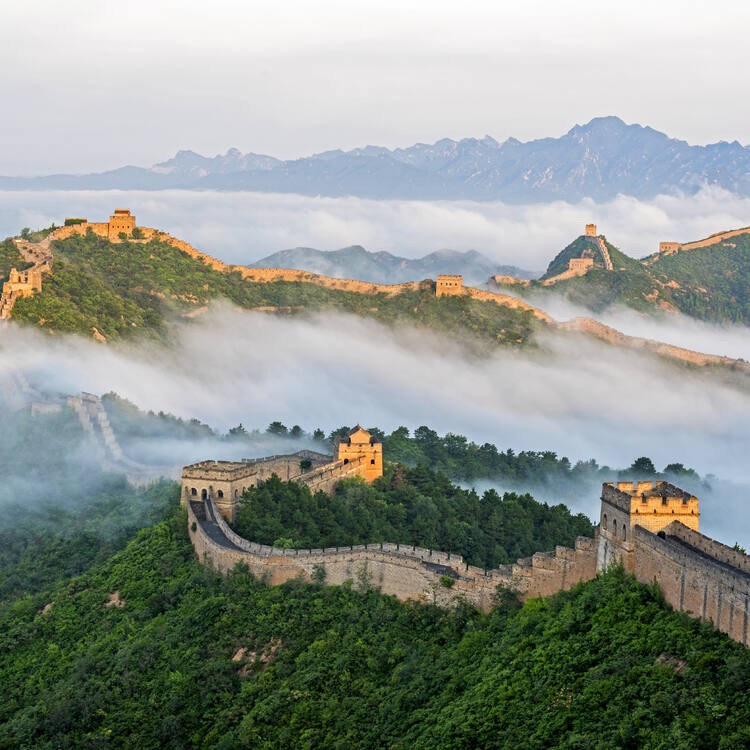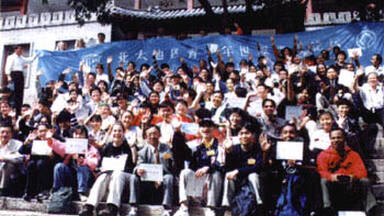The Great Wall
The Great Wall
In c. 220 B.C., under Qin Shi Huang, sections of earlier fortifications were joined together to form a united defence system against invasions from the north. Construction continued up to the Ming dynasty (1368–1644), when the Great Wall became the world's largest military structure. Its historic and strategic importance is matched only by its architectural significance.
Description is available under license CC-BY-SA IGO 3.0
La Grande Muraille
Vers 220 av. J.-C., Qin Shin Huang entreprit de réunir des tronçons de fortifications existants pour en faire un système défensif cohérent contre les invasions venues du nord. Poursuivis jusque sous les Ming (1368-1644), ces travaux ont produit le plus gigantesque ouvrage de génie militaire du monde. Son importance historique et stratégique n'a d'égale que sa valeur architecturale.
Description is available under license CC-BY-SA IGO 3.0
السور العظيم
قرابة العام 220 ق.م. بدأ كين شين هوانغ يجمع بقايا حصون قائمة ليُشكّل فسيفساء نظام دفاع متسقِ في وجه اجتياحات الشمال. وتتابعت هذه الأعمال أثناء حكم سلاسة مينغ (1368-1644) فأثمرت أعظم إبداع عسكري عملاق في العالم. ولا توزاي أهميّة السور التاريخيّة والإستراتيجيّة سوى قيمته الهندسيّة.
source: UNESCO/CPE
Description is available under license CC-BY-SA IGO 3.0
长城
公元前约220年,秦始皇下令将早期修建的一些分散的防御工事连接成一个完整的防御系统,用以抵抗来自北方的侵略。长城的修建一直持续到明代(1368至1644年),终于建成为世界上最大的军事设施。长城在建筑学上的价值,足以与其在历史和战略上的重要性相媲美。
source: UNESCO/CPE
Description is available under license CC-BY-SA IGO 3.0
Великая Китайская Стена
В 220-х гг. до н.э. во времена правления Цинь Шихуанди участки построенных ранее укреплений были сведены в единую оборонительную систему против вторжений с севера. Строительство продолжалось вплоть до времени династии Мин (1368-1644 гг.), когда Великая Китайская Стена стала крупнейшим в мире военным сооружением. Ее историческая и стратегическая важность может сравниться только с ее архитектурной значимостью.
source: UNESCO/CPE
Description is available under license CC-BY-SA IGO 3.0
La Gran Muralla
Hacia el año 220 a.C., el primer emperador Qin Shin Huang ordenó reunir los tramos de fortificaciones construidas anteriormente, a fin de crear un sistema de defensa coherente contra las invasiones de los pueblos del Norte. Los trabajos de edificación de la Gran Muralla prosiguieron hasta la dinastía de los Ming (1368-1644), dando por resultado la obra de ingeniería militar mí¡s gigantesca de todos los tiempos. Su gran valor arquitectónico es comparable a su importancia histórica y estratégica.
source: UNESCO/CPE
Description is available under license CC-BY-SA IGO 3.0
万里の長城
source: NFUAJ
Chinese Muur
Source: unesco.nl
Outstanding Universal Value
Brief synthesis
The Great Wall was continuously built from the 3rd century BC to the 17th century AD on the northern border of the country as the great military defence project of successive Chinese Empires, with a total length of more than 20,000 kilometers. The Great Wall begins in the east at Shanhaiguan in Hebei province and ends at Jiayuguan in Gansu province to the west. Its main body consists of walls, horse tracks, watch towers, and shelters on the wall, and includes fortresses and passes along the Wall.
The Great Wall reflects collision and exchanges between agricultural civilizations and nomadic civilizations in ancient China. It provides significant physical evidence of the far-sighted political strategic thinking and mighty military and national defence forces of central empires in ancient China, and is an outstanding example of the superb military architecture, technology and art of ancient China. It embodies unparalleled significance as the national symbol for safeguarding the security of the country and its people.
Criterion (i): The Great Wall of the Ming is, not only because of the ambitious character of the undertaking but also the perfection of its construction, an absolute masterpiece. The only work built by human hands on this planet that can be seen from the moon, the Wall constitutes, on the vast scale of a continent, a perfect example of architecture integrated into the landscape.
Criterion (ii): During the Chunqiu period, the Chinese imposed their models of construction and organization of space in building the defence works along the northern frontier. The spread of Sinicism was accentuated by the population transfers necessitated by the Great Wall.
Criterion (iii): That the Great Wall bear exceptional testimony to the civilizations of ancient China is illustrated as much by the rammed-earth sections of fortifications dating from the Western Han that are conserved in the Gansu province as by the admirable and universally acclaimed masonry of the Ming period.
Criterion (iv): This complex and diachronic cultural property is an outstanding and unique example of a military architectural ensemble which served a single strategic purpose for 2000 years, but whose construction history illustrates successive advances in defence techniques and adaptation to changing political contexts.
Criterion (vi): The Great Wall has an incomparable symbolic significance in the history of China. Its purpose was to protect China from outside aggression, but also to preserve its culture from the customs of foreign barbarians. Because its construction implied suffering, it is one of the essential references in Chinese literature, being found in works like the "Soldier's Ballad" of Tch'en Lin (c. 200 A.D.) or the poems of Tu Fu (712-770) and the popular novels of the Ming period.
Integrity
The Great Wall integrally preserves all the material and spiritual elements and historical and cultural information that carry its outstanding universal value. The complete route of the Great Wall over 20,000 kilometers, as well as elements constructed in different historical periods which constitute the complicated defence system of the property, including walls, fortresses, passes and beacon towers, have been preserved to the present day. The building methods of the Great Wall in different times and places have been integrally maintained, while the unparalleled national and cultural significance of the Great Wall to China is still recognised today. The visual integrity of the Wall at Badaling has been impacted negatively by construction of tourist facilities and a cable car.
Authenticity
The existing elements of the Great Wall retain their original location, material, form, technology and structure. The original layout and composition of various constituents of the Great Wall defence system are maintained, while the perfect integration of the Great Wall with the topography, to form a meandering landscape feature, and the military concepts it embodies have all been authentically preserved. The authenticity of the setting of the Great Wall is vulnerable to construction of inappropriate tourism facilities.
Protection and management requirements
The various components of the Great Wall have all been listed as state or provincial priority protected sites under the Law of the People’s Republic of China on the Protection of Cultural Relics. The Regulations on the Protection of the Great Wall promulgated in 2006 is the specific legal document for the conservation and management of the Great Wall. The series of Great Wall Conservation Plans, which is being constantly extended and improved and covers various levels from master plan to provincial plans and specific plans, is an important guarantee of the comprehensive conservation and management of the Great Wall. China’s national administration on cultural heritage, and provincial cultural heritage administrations where sections of the Great Wall are located, are responsible for guiding the local governments on the implementation of conservation and management measures for the Great Wall.
The Outstanding Universal Value of the Great Wall and all its attributes must be protected as a whole, so as to fulfill authentic, integral and permanent preservation of the property. To this end, considering the characteristics of the Great Wall, including its massive scale, transprovincial distribution and complicated conditions for its protection and conservation, management procedures and regulations, conservation interventions for the original fabric and setting, and tourism management shall be more systematic, scientific, classified, and prioritized. An efficient comprehensive management system, as well as specific conservation measures for the original fabric and setting will be established, while a harmonious relationship featuring sustainable development between heritage protection and social economy and culture can be formed. Meanwhile, the study and dissemination of the rich connotation of the property’s Outstanding Universal Value shall be enhanced, so as to fully and sustainably realize the social and cultural benefits of the Great Wall.

 View photos from OUR PLACE the World Heritage collection
View photos from OUR PLACE the World Heritage collection
